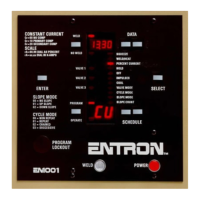ENTRON Controls, LLC. • 700120S • Page 41
The main isolation is provided by electro-mechanical control relay contacts that are in series
with the solenoid valve voltage supply and the contactor firing circuitry. In a non-initiated
state, the relay contacts are open and no output from these circuits are possible. When the
control is initiated by the physical closure of a normally open set of external contacts (commonly
a foot switch) across the initiation circuit, the relays are energized and their contacts close and
complete the circuits to the solenoid valve and the contactor. The outputs are not actually
energized, however, until the microprocessor reaches the point in the sequence at which the
valve or contactor outputs are to be activated.
There is no way to guarantee that any control circuit will be immune to component failure. It is
always necessary to take personal safety precautions when operating any machinery. Through
a PROCESS OUTPUT system, the EN1000 Series Controls can be programmed so that if the
20 volt energizing voltage for the isolation relays appears in the absence of an initiation, or if
the SCR contactor conducts current at any time other than when programmed, an output voltage
will appear at the Valve 3 terminals. This voltage can be used to sound an alarm or operate a
shunt trip breaker to remove line voltage from the machine and the control.
In addition to the relay contacts mentioned above, there are other levels of isolation. The initiation
signals first pass through a circuit comprised of opto-isolators before being passed to the input
circuitry of the microprocessor. The valve outputs are further isolated by the use of optically
coupled triac (solid state) outputs and the weld pulses are isolated by a pulse transformer.
Valve 3 (SV5/SV6) will not be isolated if Jumper B is used on TS3 (see Figure 4-13).
4.7 ISOLATION CIRCUITRY DESCRIPTION (cont.)
NOTICE

